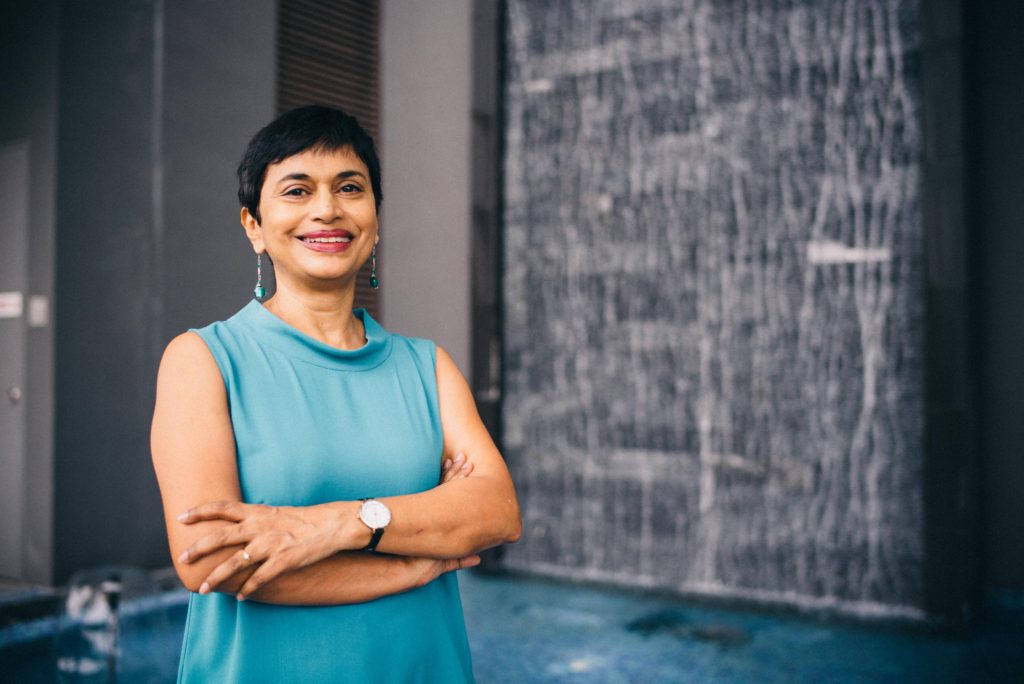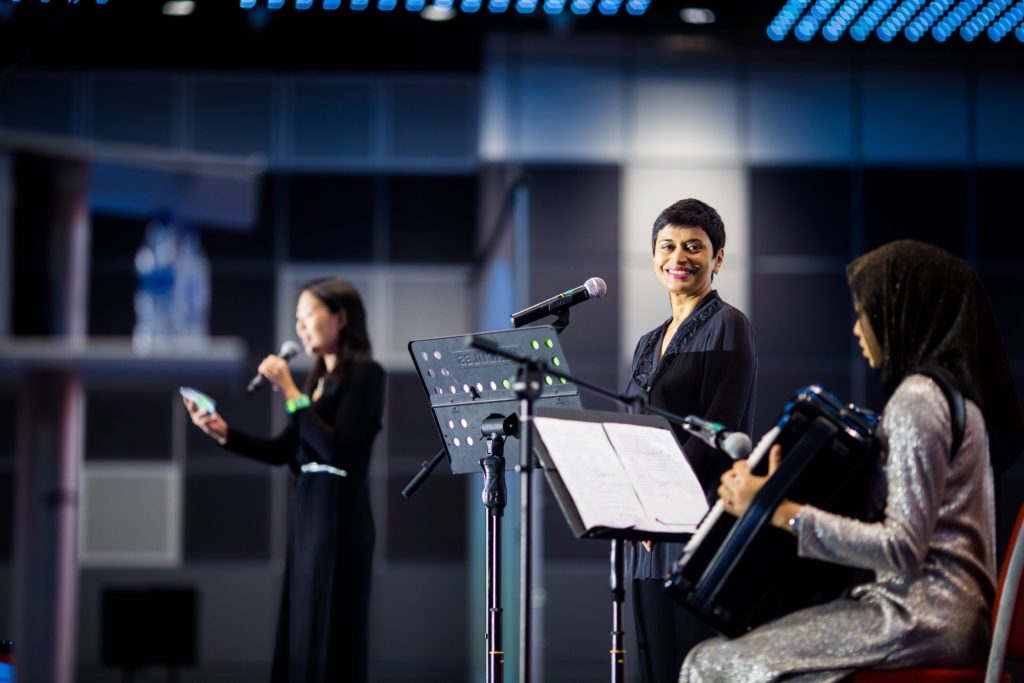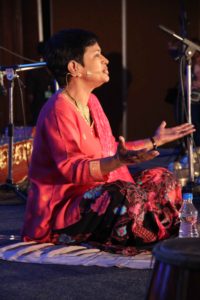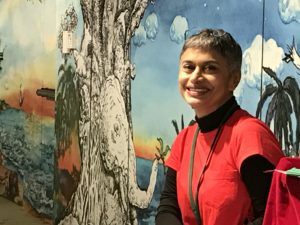SDEA Spotlight: Rosemarie Somaiah
by SDEA

SDEA Spotlight is a series of short interviews with SDEA members that peel back the curtain behind their practice, their beliefs about arts and drama education and their influences. Rosemarie Somaiah runs Asian Storytelling Network and has more than twenty years of experience as an arts educator in Singapore.
1. What are you working on at the moment?
There have been several public events including two in the last two weeks. I recently shared the stage with many talented young performers and ensembles in a contemporary show called Sea Dreams with Global Cultural Alliance at VivoCity. I also have storytelling sessions at the National Museum of Singapore. I am in rehearsals for another show at the Asian Festival of Children’s Content coming up, working once again with BronzAge gamelan. My regular teaching commitments under Asian Storytelling Network (ASN) remain, especially with Child at Street 11, a non-profit organisation for children and families that I have worked with since 2005. ASN’s NAC approved programmes for schools continue to attract interest and I will work once more with a secondary school as Writer in Residence using storytelling within the curriculum. I am also doing the Special Diploma in Arts Education.
**

- What’s the direction of your work? Has it changed over the years?**
My work in storytelling and education has always been needs-based. Clients often approach me with a hazy idea. I discuss it, clarify the main ideas and then I suggest some options, and usually it seems to work. As I work with all ages, including corporate and community organisations, there is a broad range, including conceptualising, writing, performing, and providing training in storytelling for a wide range of applications. That has not changed. However, I am happy that there is now a little more understanding of the importance of storytelling and that attention is being paid to under-served communities, including preschools, special schools, the elderly and the marginalised communities.
**

- What is a dream project that you hope to do?**
I would like to work with artists and thinkers on a long term project that has both depth and breadth, and will help to anchor and record the resurgence in the art of storytelling in Singapore today. I am grateful that people who have worked with me on earlier events have come back again and again. Hopefully, it will eventually build up into something that will serve to expand the understanding of the power of story within the Singapore context and also has relevance and resonance anywhere in the world.
4. How did you start out doing what you do?
I arrived in Singapore, as a dependent spouse in 1982. Before I arrived, I had read that it was multi-cultural and Indians were part of its history. As a working woman then, I assumed that it would be easy to find work. I understood that the country needed my husband’s skills but not mine – at that time. My educational qualifications were not recognised. However I am strongly influenced by my parents, both well-educated people with courage and conviction who believed that one must contribute actively to shape the society one lives in. So, in gratitude for what I already had, I began to volunteer here too. This is common in the society I came from and has nothing to do with clocking up ‘volunteer hours’! My life here has always been uncertain and it took us seven years to be able to apply for Permanent Resident status. But based on what work I had done, I would get other requests, especially to teach. People tell me that I have a ‘teacher face’. Both my family and my husband’s family have a long history in education so perhaps it is not surprising that after trying a few other industries, I found my passion in storytelling and education. I finally became a citizen a decade back, after 25 years in Singapore. By then I had already been a drama educator and storyteller and training teachers for several years.
5. How do you keep your work fresh?
I do not resist change. It is exciting to work with young conceptual artists and musicians. I like being challenged and pushing the boundaries and creating something new every time. And I still prefer to count my blessings.
6. What do you think makes a perfect drama educator?
I think a perfect drama educator recognises that none of us is perfect. Perfect situations when things work out exactly as planned are to be welcomed and treasured as something serendipitous. Drama educators work hard to create the space for special things to happen, working with trust and acceptance of diverse ways of thinking, being and feeling. But there will always be challenges, and accepting this, recognising that this is what makes a story or situation intriguing and what helps us move it forward, is probably a good attribute for a drama educator to have.
**

- Why is drama important? Why should it be taught in schools?**
Life is uncertain and complex, and drama is a good and valuable way to test our assumptions and challenge ourselves to think in more meaningful ways connected to life and living. Children are not simply heads connected to hands and examination scripts; a full life does not mean just work. While some might obsess about specific definitions and theories, I think drama has the potential to include all aspects of what makes life meaningful – thinking, feeling, moving, imagining, living and expressing ourselves in many ways. Whether or not you intend to be a performer is not the question. Many of us do not intend to become mathematicians or scientists, yet basic math and science are generally compulsory subjects within general education. In the same way, a basic understanding and exposure to drama is important in school. It ticks many of the boxes for 21st century competencies currently being recommended in schools, while providing a more holistic education.
8. Who was the drama educator that has the most impact on you?
Not one, but many, in a natural, intuitive way. In my school the arts was much respected. A math teacher could quote poetry and a science teacher might also be a trained dancer. Literature including poetry and drama were part of the curriculum from the start. At the higher levels there were inter-class drama competitions which were eagerly anticipated events on the school calendar. There was also a school play that the public was invited to. Sometimes it was a musical, at other times it could be comedies or tragedies, classic or contemporary. So it was an integral part of the school curriculum.
9. What is your most memorable moment in the classroom/on stage?
I studied in a girls school so while other girls might want the part of the ‘pretty girl’, I often played what to me were the more interesting parts - the mad man, the jester, the witch, the wise old woman, and the male roles. And yes, I have also played the pretty girl. I was surprised to find that people enjoyed watching me in these varied roles and remembered them. But to me it was part of the whole play and, while I enjoyed the experience of inhabiting another body, I just did what I had been assigned to do. It is that experience that helps me in schools today. I find other people’s stories fascinating. I can recall many instances when students were deeply moved by a simple oral story or a reading of a passage from a literature text.
**

- Share a drama activity that you love to do.**
I work with simple drama activities such as ‘This is a Tick! / This is a Tock!’ and adapt it to various situations. Very short stories that incorporate drama strategies such as ‘Two Goats’ are also very valuable. I find these activities can shift perspectives and trigger quite a bit of reflection from the participants.
11.What do you hope to see in Singapore's drama/theatre landscape in future?
I would like to see a greater acceptance of drama and theatre as a natural human way of exploring and commenting on our human condition as well as celebrating it – in all its weird and wonderful complexity!
12. In one word, sum up your drama education journey.
Extant.



